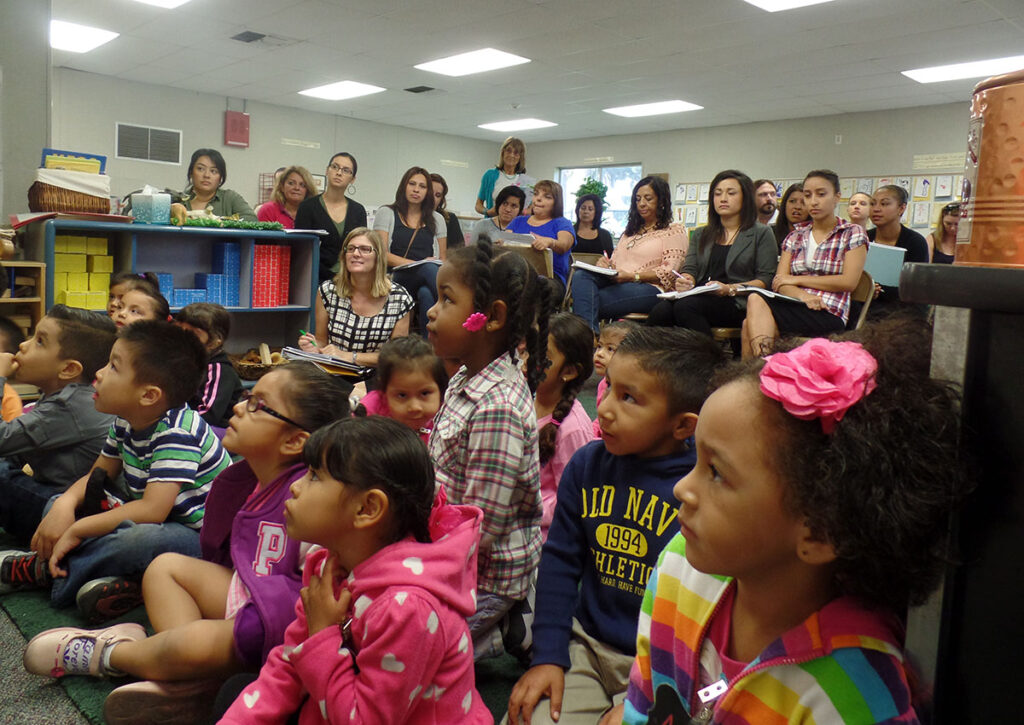 Sarah Tully/EdSource
Sarah Tully/EdSource Sarah Tully/EdSource
Sarah Tully/EdSourceEven as families continue to take stock of pandemic-triggered learning loss and emotional upset, California is expanding an early childhood education program that may help young learners begin to bounce back.
Next year, transitional kindergarten, or TK, will be available to far more 4-year-olds. In the 2023-2024 school year, children whose fifth birthdays are between Sept. 2 and April 2 will be eligible for the program. By the 2024-25 school year, children who turn 5 between Sept. 2 and June 2 will be able to enroll in TK. And by 2025-26, the program will reach all 4-year-olds.
Many districts are beginning to register new students for the coming year so now is the time to reach out. Here’s a quick primer on 10 things parents should know about expanded transitional kindergarten, a $2.7 billion program hailed by many experts as a game-changer for families in a state with almost 3 million children under the age of 5.
1. Why is early childhood education so significant?
The first three years of life are often described as the brain’s window of opportunity, experts say, a time of great promise. The most critical growth happens at the beginning, with the size of the brain doubling in the first year. Given that 90% of brain growth happens before kindergarten, it’s important that children receive enough intellectual and social stimulation to help build the architecture of the brain.
2. What is transitional kindergarten, or TK? Is it mandatory?
TK is often described as a steppingstone between preschool and kindergarten, which is now more academically rigorous than it once was. Both TK and kindergarten are optional. Children are only required to attend school in California once they turn 6. Until that age, it is up to parents to decide whether to enroll their children in kindergarten or preschool or keep them at home. However, in recent years momentum has been building in the Legislature to make kindergarten both mandatory and full-day in an attempt to help close the widening achievement gap.
3. Is TK free? How is it paid for?
Children can attend TK at no cost because it is part of California’s K-12 public school system. Districts receive funding for TK students based on average daily attendance.
4. Why was TK created in the first place?
TK came about after the Legislature approved the Kindergarten Readiness Act in 2010. Until then, children who were 4 years old on Sept. 1 could still enroll in regular kindergarten as long as they turned 5 by Dec. 2 of that year. But the new law changed that. Beginning in 2012, children had to be 5 by Sept. 1 to enroll in kindergarten.
That switch left out about 100,000 children, forcing them to wait an extra year to start school. Transitional kindergarten was originally established in 2012 to serve these 4-year-olds, the ones who would have previously been eligible for kindergarten. Teachers often referred to these students as “the fall babies.”
5. What is the difference between the original TK program and the new transitional kindergarten program?
TK originally served only 100,000 children, primarily those who turn 5 between Sept. 2 and Dec. 2. These are the students who narrowly missed the cutoff date for regular kindergarten. The new $2.7 billion universal TK program, by contrast, will eventually be available to every 4-year-old in California, serving nearly 400,000 students. It will essentially function as California’s version of a universal preschool program, available to all children regardless of income.
6. How long will it take for the expanded transitional kindergarten program to be fully rolled out?
The plan is to gradually phase in younger students each year until all 4-year-olds are eligible by 2025-26. However, some school districts are ahead of the curve, having already expanded TK to most 4-year-olds. Check with your local district for details.
7. Will TK be a full-day or a half-day program?
TK, like kindergarten, is a local choice of full-day or part-day. However, many districts offer before- and after-school services through the state’s Expanded Learning Opportunities program.
8. Do children in TK have to meet the same vaccination requirements as in regular kindergarten?
Yes. The same vaccination criteria apply.
9. What can parents do to help prepare their children for starting transitional kindergarten?
There are many skills children can practice at home, from cutting with safety scissors and holding a pencil to using a glue stick. All of these activities help build fine motor skills. On the academic front, teachers recommend that parents spark early math skills by counting things around the house and talking about bigger versus smaller. Reading is also key. Spend quality time cuddled up with a book every day so that children associate reading with warmth, affection and fun.
10. What’s often the biggest challenge for families?
Separating from parents and guardians is often the biggest hurdle for children who haven’t been going to day care or preschool, experts say. While this milestone can be tear-filled for parents and children alike, it doesn’t last forever. Just say your goodbyes, teachers advise, and let the staff handle it. The longer you linger, they warn, the harder it will be on both of you.
To get more reports like this one, click here to sign up for EdSource’s no-cost daily email on latest developments in education.


Comments (5)
Comments Policy
We welcome your comments. All comments are moderated for civility, relevance and other considerations. Click here for EdSource's Comments Policy.
Joyce L Robinson 6 months ago6 months ago
Although the 10 things are important for parents to understand about transitional kindergarten, we need to be educating parents on what is developmentally appropriate practice for young children and the value of play in early childhood classes. We should also be warning them about the harmful effects of mandatory homework and ditto sheets for young children.
gina lovejoy 6 months ago6 months ago
1) it’s not free, its paid for by our taxes, 2) it’s a money grabber, 3) it’s really not needed. We need to stop forcing our children into an academics. We are last in education; might this be do to these types of programs? Look at other countries. Look at the research that shows all is lost by 3rd grade
Jack Jarvis 6 months ago6 months ago
This was supposed to be a stop-gap program that morphed into a permanent program. The curriculum is nonexistent, and inconsistent training and support has led to districts having trouble getting teachers to take the assignment. Having been in various districts all over the state since 2016 as a consultant and student teacher coach and professor, it’s painful but predictable to see the lack of coherency and direction.
TERESA SARGENT-MAIDEN 6 months ago6 months ago
This is great info, can I give this info out to my special needs families for reference? Or are they under a different plan?
Emily Cremidis 6 months ago6 months ago
Karen, thank you for this article. It lends clarity to a subject that is hazy for many parents. And you are spot on regarding the detrimental effects of lingering.